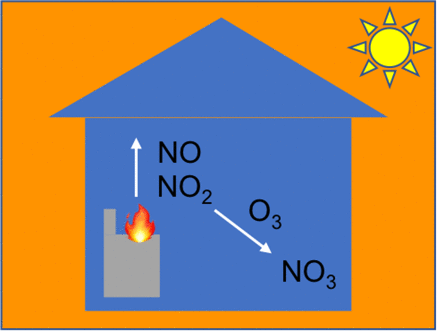当前位置:
X-MOL 学术
›
Environ. Sci. Technol. Lett.
›
论文详情
Our official English website, www.x-mol.net, welcomes your feedback! (Note: you will need to create a separate account there.)
Measurement of NO3 and N2O5 in a Residential Kitchen
Environmental Science & Technology Letters ( IF 10.9 ) Pub Date : 2018-09-21 , DOI: 10.1021/acs.estlett.8b00415 Caleb Arata , Kyle J. Zarzana 1, 2 , Pawel K. Misztal , Yingjun Liu , Steven S. Brown 1, 3 , William W Nazaroff , Allen H. Goldstein
Environmental Science & Technology Letters ( IF 10.9 ) Pub Date : 2018-09-21 , DOI: 10.1021/acs.estlett.8b00415 Caleb Arata , Kyle J. Zarzana 1, 2 , Pawel K. Misztal , Yingjun Liu , Steven S. Brown 1, 3 , William W Nazaroff , Allen H. Goldstein
Affiliation

|
We present direct indoor measurements of the nitrate radical (NO3) and dinitrogen pentoxide (N2O5) produced from combustion cooking emissions in a residential kitchen. When the indoor ozone (O3) concentration was low (∼4 ppbv), nitric oxide (NO) emitted from gas stove combustion suppressed NO3 formation. However, at moderate O3 levels (∼40 ppbv), measured NO3 concentrations reached 3–4 pptv, and the indoor NO3 reactivity loss rate coefficient reached 0.8 s–1. A box model of known chemistry agrees with the reactivity estimate and shows that moderate O3 levels led to a nitrate radical production rate of 7 ppbv h–1. These indoor NO3 production rates and reactivities are much higher than those typically found outdoors. We conclude that at low O3 levels indoor combustion suppresses nitrate radical chemistry, but when sufficient O3 enters residences from outdoors or is emitted directly from indoor sources, gas stove combustion emissions promote indoor NO3 chemistry.
中文翻译:

住宅厨房中NO 3和N 2 O 5的测量
我们介绍了住宅厨房中燃烧烹饪排放物产生的硝酸根(NO 3)和五氧化二氮(N 2 O 5)的直接室内测量值。当室内臭氧(O 3)浓度较低(〜4 ppbv)时,燃气灶燃烧产生的一氧化氮(NO)会抑制NO 3的形成。但是,在中等O 3水平(〜40 ppbv)下,测得的NO 3浓度达到3-4 pptv,室内NO 3的反应性损失率系数达到0.8 s –1。已知化学的盒模型与反应性估计值吻合,表明中等O 3的水平导致硝酸根自由基的产生率为7 ppbv h –1。这些室内NO 3的产生率和反应性比通常在室外发现的要高得多。我们得出的结论是,在低O 3水平下,室内燃烧会抑制硝酸根自由基化学反应,但是当足够的O 3从室外进入住宅或直接从室内排放时,燃气灶的燃烧排放会促进室内NO 3的化学反应。
更新日期:2018-09-21
中文翻译:

住宅厨房中NO 3和N 2 O 5的测量
我们介绍了住宅厨房中燃烧烹饪排放物产生的硝酸根(NO 3)和五氧化二氮(N 2 O 5)的直接室内测量值。当室内臭氧(O 3)浓度较低(〜4 ppbv)时,燃气灶燃烧产生的一氧化氮(NO)会抑制NO 3的形成。但是,在中等O 3水平(〜40 ppbv)下,测得的NO 3浓度达到3-4 pptv,室内NO 3的反应性损失率系数达到0.8 s –1。已知化学的盒模型与反应性估计值吻合,表明中等O 3的水平导致硝酸根自由基的产生率为7 ppbv h –1。这些室内NO 3的产生率和反应性比通常在室外发现的要高得多。我们得出的结论是,在低O 3水平下,室内燃烧会抑制硝酸根自由基化学反应,但是当足够的O 3从室外进入住宅或直接从室内排放时,燃气灶的燃烧排放会促进室内NO 3的化学反应。


























 京公网安备 11010802027423号
京公网安备 11010802027423号